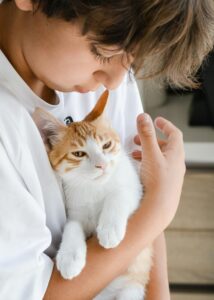Cats just like dogs have been domesticated for thousands of years by humans which has helped the feline folks to create a unique and close bond with humans.
They have lived with humans and shared in almost every area of their lives in many ways and years.
They have also learned to co-exist with humans in a symbiotic manner.
Although some might argue they are independent and supercilious animals like wildcats, this has not affected their unique relationship with their new housemates (Humans).
Cats are not pack animals such as other domesticated pets like dogs.
Neither are they also social creatures with their kind like humans, but they show social behaviors that have enabled them to bond with their caregivers in harmony.
Why Do Cats Like Humans:

Cats have grown to love humans over the years largely due to the provision of their needs.
Due to the fact they have been domesticated for so many years, they have largely depended on humans for their needs such as food and water, shelter, safety, hygiene, grooming, healthcare, etc.
Their dependence on humans has enabled them to form social bonds with humans most especially their caregivers.
They have also evolved to like humans]because humans don’t compete for the same resources unlike other cats and other animals such as dogs.
Food And Water:

Cats are carnivores, meaning their nutritional needs can only be met by consuming enough animal-based proteins.
Although cats have been domesticated for so many years alongside dogs that have evolved to be omnivores like humans, Cats have retained their age-long dietary needs.
The dietary needs of cats mean domesticated cats have to rely on their human caregivers to provide for their feeding needs else they will have to feed by hunting.
Humans provide both commercial foods and homemade meals to cats.
They provide lean fresh meats such as turkey, beef, lamb, fish, pork, etc.
They also provide dry cat foods which are more convenient for cats based on the standards of AAFCO (Association of American Feed Control Officials) and wet cat foods in different forms in trays, cans, and pouches that are needed for hydration in cats.
The provision of food and also clean and fresh water by humans has endeared them to cats over the years making humans a friend and companion to cats.
Shelter And Safety:
Cats have learned to live and depend on humans for their basic needs such as shelter and safety.
They have lived either in the same living space as humans or they have been provided a special and conducive living space.
By living with humans in the same living space or nearby when they are provided with their own space, they have closely interacted, learned to share, and also studied humans.
They have felt the generosity and true kindness of humans.
The provision of living space has also secured them away from prying predators such as owls, eagles, mountain lions, hawks, snakes, etc.
It has kept them away from potential dangers in the wild where survival of the fittest is the norm.
Healthcare Needs:
Cats can self-groom themselves to keep their coats clean and parasites-free.
They can also sunbathe to absorb vitamin D. However, they will solely depend on humans for their essential healthcare needs.
Humans provide vaccines, treat illnesses, and sicknesses, and monitor and care for them like a mother when they are sick.
This show of great concern and compassion endears cats to humans in no little way as they can’t do it for themselves.
Hygiene And Grooming:
Cats can groom their claws by scratching which is a natural behavior.
This natural behavior is also used by them to mark territories.
In some cases, when they are either ill or old, humans help them to groom their claws when they can no longer self-groom.
Humans sometimes help to bathe when they get very dirty, they also help to trim their nails to avoid discomfort from overgrown nails
Humans also provide dental care by cleaning their teeth through regular brushing which helps to prevent dental disease.
They also provide eye care. The attention to care makes them comfortable, and clean and this endears them to humans.
Why Dont They Like Other Cats:
Cats are territorial animals which means they guard and prevent other animals including their kind from their marked territories.
The reason why they prevent other animals including their kind is to fend off competition for food, shelter, and water.
They are naturally solitary animals and the presence of others poses a threat or competition for limited resources.
Cats, unlike dogs that are strong packs, do not easily get along with other cats due to variances in personality traits even among the same breed. this can easily cause conflicts and possible fights
Can A Cat Be Friends With Other Cats:
Yes, a cat can get along and be friends with other cats based on personal preference, and if the other cat does not possess any threat to compete for resources.
Their relationships with other cats are not as great as social and pack animals like dogs.
Socialization with other cats is best and easier when they are kittens.
As kittens, there is little to no fight for resources so bonds can be strong if they grow together.
They can also easily bond and be friends with other cats if they are groomed together and also engage in fun activities such as playing with toys.
How Do Cats See Humans:
Cats do not see humans as other big cat.
Instead as another species of animal, they can have a good relationship with largely influenced by years of domestication.
They perceive humans in a unique way shaped by relationships, evolutionary history, and sensory capabilities.
Cats have a strong sense of smell which they do use to tell the differences in humans. they can easily detect and tell subtle differences in scents and smells.
They recognize the differences in size, physical features, and abilities. they can also tell the differences between humans and other animals from smell and sounds.
Cats do recognize human abilities to provide them with shelter, food, water, and healthcare needs when they are injured or sick.
Cats do have a great understanding of body language. they can interpret human gestures and also communicate the same way by tail waggling etc.

